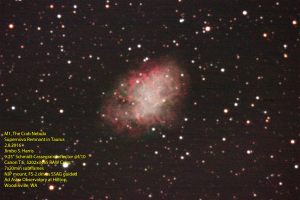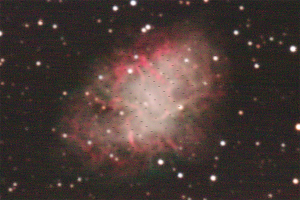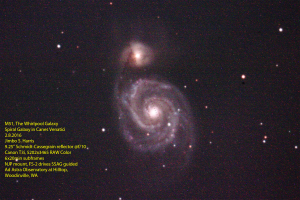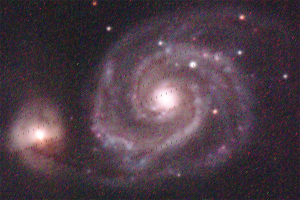I finally scored a really beautiful night. It was clear as I was driving home, so I decided to hit the observatory as soon as I got home. This was the first full night with Cassie, so I spent a little time, making sure that the scope was all ready to roll, tweaked the balance a bit, etc. Focusing with the Bahtinov mask was really easy again; the T3i live view seems like a real winner.
I am still thrashing around with target selection; Cassie’s FOV is so tiny that I need to re-think the size of DSOs I’m shooting. I realized that a couple of targets that I was avoiding as “too small” in Veronica and Pumpkin are now in range. M1, The Crab Nebula, is a target that I haven’t spent a lot of time on, for just this reason.
I set up on the horn of Taurus, and settled in for a long evening of astronomy. Guiding is working again, so 20m subframes were the order of the day. I was interested to see how the 0.4″/px camera would hold up under 1″-2″ seeing, and I was surprised and pleased to see round stars in the first subframe!
I texted my friend, M_, and mentioned how clear and pretty it was outside, and he wanted to bring his son over to see the observatory in action. I warned them to bundle up, because the temperature was rapidly dropping into the mid-20s. By the time they showed up, I’d already gotten 4 subframes in the can, so I wasn’t too bothered when M_ bumped into the telescope during the tour of the observing deck. I’m going to have to find a better way to verbally describe how to see whether the scope is blocked by the shutter, because people always want to get up close to the OTA, when you really want to be way back, to get a perspective view… someday I’ll get it all together 🙂
From the observing deck, I started pointing out constellations through the shutter. I think that the restricted view of the sky helped M_ and his son grok where I was pointing, plus there’s a cool factor to seeing stars through the slit in an observatory dome. We eventually decided to head outside, as the restricted view was preventing some context. I pointed out Orion, Canis Major and Minor, Taurus, Aries, Gemini, Leo, Jupiter, Ursa Major and Minor, the Pleiades, Polaris..
We decided to grab Kelly and take a closer look at a few objects. Jupiter was first. It’s always fun to see someone’s reaction, the first time they see a planet through a telescope. M_ wanted to try pointing the scope, so I had him point at The Orion Nebula, another crowd-pleaser. Finally, he wanted to see Sirius, and pointed the scope over there with ease. I wish that I could put Kelly a little higher in the air, since we were all kneeling in cold, damp grass to see through the eyepiece. But a fun time was had by all.
When we came in to put away Kelly, I noticed that the original 6 subframes of M1 had finished, so I just started another set, while I saw M_ back to the driveway (it was a school night, after all).
I ended up with 8 frames of M1, all usable, except for the “personal foul”.

Man, that is one zoomed in FOV. Here is a center crop:

Once M1 started setting over the house, I looked for a target in the East that I’d be able to shoot without having to move the dome quite so much (there’s a limited set of declinations that allow me to more or less go straight from East to zenith — I’ll calculate it all later, but for now, I just call this area of the sky “The Napping Zone”), and settled on M51. I got re-positioned, got a set of six 20m subframes rolling, and took a nap in The Comfy Chair. Sleeping bag, ski jacket, and an alarm on the iPad. Life is good.
When I woke up, there were 6 minutes left on the final subframe (talk about good timing!), so I let it run, and started working on getting the observatory shut down for the night (it was about 1:30am). Once the image was finished, shut down the mount, park the dome, and lock up. I think it’s maybe my favorite part of having an observatory, just being able to lock it and walk away.
Here’s M51, what a photogenic galaxy pair. I’d always love more detail, but this is not a bad effort. Note that in this photo, North is “up”, as usual.

In order to do my normal 1500×1000 -> 900×600 “full scale crop”, I had to rotate the object 90º CCW, because that fit inside the box better. So in this image, North is “left”.

The seeing was a little rough when I first got out there, around 2″, but it settled down later in the evening, to more like 1″. I wonder if there is a thing with air currents inside the observatory, or whether that’s a “sky” thing. Something else to think about later.
Also, I need to look at the ISO settings in the latest iteration of the software config, because I am a bit concerned that the T3i doesn’t seem particularly sensitive. It didn’t bite me very bad tonight; both targets were quite bright. But this is when I remembered to mention it.
This February seems to be a bit wetter than the last couple, but it’s nice to see that we can still get a really pretty night now and again.
Hilltop Observatory brought in some visitors! woot!

MOST COMMENTED
Observatory
Observatory 2.0 – Time has come today!
General / Maintenance
First Light, a deeper look
Mount / Observatory / Telescope
Observatory 2.0 – Result!
Observatory
Observatory 2.0 – The Pier goes in
Gear / General / Maintenance
Martin Farmer Wormblock installation notes
Deep Sky / Long Exposure Photography
NGC2244, The Rosette Nebula
Deep Sky / Long Exposure Photography
Another beautiful night.